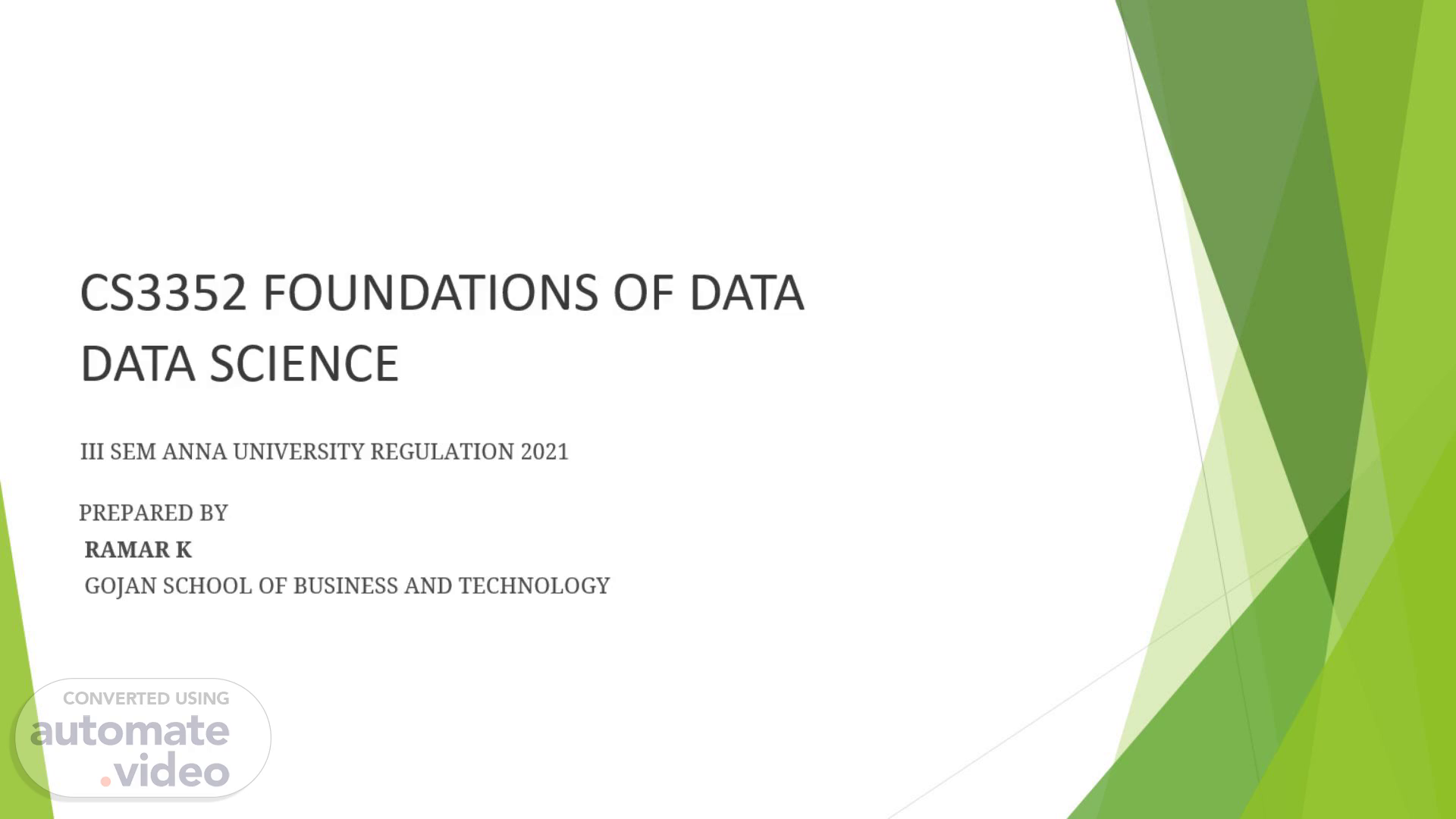Scene 1 (0s)
[Audio] CS3352 FOUNDATIONS OF DATA SCIENCE III SEM ANNA UNIVERSITY REGULATION 2021 PREPARED BY RAMAR K GOJAN SCHOOL OF BUSINESS AND TECHNOLOGY CS3352 FOUNDATIONS OF DATA SCIENCE III SEM ANNA UNIVERSITY REGULATION 2021 PREPARED BY RAMAR K GOJAN SCHOOL OF BUSINESS AND TECHNOLOGY.
Scene 2 (25s)
[Audio] Unit I: Introduction to Data Science Data Science Fundamentals Facets of Data Data Science Process Understand different data types and their characteristics. Overview of the end-to-end data science workflow. Explore core concepts and definitions. Key Steps Model Building & Presentation Defining goals, data retrieval, preparation, and analysis. Developing models and communicating findings. Unit I: Introduction to Data Science Data Science Fundamentals Explore core concepts and definitions. Facets of Data Understand different data types and their characteristics. Data Science Process Overview of the end-to-end data science workflow. Key Steps Defining goals, data retrieval, preparation, and analysis. Model Building & Presentation Developing models and communicating findings..
Scene 3 (1m 12s)
[Audio] What is Data Science? Data Science is a multidisciplinary field focused on extracting meaningful insights from data. Uses statistics, programming, and machine learning. Involves collecting, cleaning, analyzing, and visualizing data. Aids in decision-making and predictions across industries..
Scene 4 (3m 47s)
[Audio] Benefits and Uses of Data Science Commercial Companies Governmental Organizations Gain insights into customers, processes, staff, and products for better user experience, cross-selling, and personalization. Discover valuable information from internal data and share public data. NGOs Universities Utilize data to raise funds and advocate for their causes. Enhance research and student study experience, especially with MOOC data. Benefits and Uses of Data Science Commercial Companies Gain insights into customers, processes, staff, and products for better user experience, cross-selling, and personalization. Governmental Organizations Discover valuable information from internal data and share public data. NGOs Utilize data to raise funds and advocate for their causes. Universities Enhance research and student study experience, especially with MOOC data..
Scene 5 (4m 49s)
[Audio] Facets of Data Understanding data characteristics is crucial for collection, processing, and analysis. Structured Data Unstructured Data Natural Language Fixed fields, easy to store in tables (e.g., databases, Excel). Managed with SQL. Context-specific, varying content (e.g., emails). Challenging to fit into models. Special unstructured data requiring linguistics and specific techniques (e.g., sentiment analysis). Machine-Generated Graph-Based Audio, Video, Images Automatically created by machines (e.g., web server logs, telemetry). High volume and speed. Focuses on relationships between objects (nodes, edges, properties), ideal for social networks. Challenging for computers to interpret, requires advanced deep learning techniques. Streaming Data Data flows in real-time as events happen (e.g., Twitter trends, stock market). Facets of Data Structured Data Fixed fields, easy to store in tables (e.g., databases, Excel). Managed with SQL. Unstructured Data Context-specific, varying content (e.g., emails). Challenging to fit into models. Natural Language Special unstructured data requiring linguistics and specific techniques (e.g., sentiment analysis). Machine-Generated Automatically created by machines (e.g., web server logs, telemetry). High volume and speed. Graph-Based Focuses on relationships between objects (nodes, edges, properties), ideal for social networks. Audio, Video, Images Challenging for computers to interpret, requires advanced deep learning techniques. Streaming Data Data flows in real-time as events happen (e.g., Twitter trends, stock market)..
Scene 6 (6m 53s)
[Audio] Data Science Process Overview 1. Defining Research Goals Establish clear objectives and context, resulting in a project charter. 2. Retrieving Data Acquire suitable raw data from internal or external sources. 3. Data Preparation Clean, combine, and transform raw data into a usable format. 4. Exploratory Data Analysis Gain deep understanding through visual and descriptive techniques, identifying patterns and anomalies. 5. Build the Model Develop models to gain insights or make predictions, often iteratively. 6. Presenting Findings & Building Applications Communicate results and automate analysis for business impact. Data Science Process Overview 1. Defining Research Goals Establish clear objectives and context, resulting in a project charter. 2. Retrieving Data Acquire suitable raw data from internal or external sources. 3. Data Preparation Clean, combine, and transform raw data into a usable format. 4. Exploratory Data Analysis Gain deep understanding through visual and descriptive techniques, identifying patterns and anomalies. 5. Build the Model Develop models to gain insights or make predictions, often iteratively. 6. Presenting Findings & Building Applications Communicate results and automate analysis for business impact..
Scene 7 (8m 31s)
[Audio] Data Preparation: Cleaning and Combining Data Cleaning Combining Data Removing errors for true and consistent data representation. Integrating information from various sources. Joining: Combines information of one observation from different tables based on common keys (e.g., customer purchases and region). Interpretation errors (e.g., age > 300 years). Inconsistencies (e.g., "Female" vs. "F"). Appending/Stacking: Adds observations from one table to another, requiring equal structure (e.g., monthly sales data). Common issues: data entry mistakes, redundant whitespace, capital mismatches, impossible values, outliers, missing values. Data Preparation: Cleaning and Combining Data Cleaning Removing errors for true and consistent data representation. Interpretation errors (e.g., age > 300 years). Inconsistencies (e.g., "Female" vs. "F"). Common issues: data entry mistakes, redundant whitespace, capital mismatches, impossible values, outliers, missing values. Combining Data Integrating information from various sources. Joining: Combines information of one observation from different tables based on common keys (e.g., customer purchases and region). Appending/Stacking: Adds observations from one table to another, requiring equal structure (e.g., monthly sales data)..
Scene 8 (10m 11s)
[Audio] Model Building and Presentation Building Models Presenting Findings Select techniques and variables, execute models using libraries (e.g., Python's StatsModels), and perform diagnostics. Communicate results effectively to stakeholders. This may involve automating reports or building applications to integrate insights into business processes. Use holdout samples to evaluate performance on unseen data and compare models based on error measures like Mean Square Error (MSE). Model Building and Presentation Building Models Select techniques and variables, execute models using libraries (e.g., Python's StatsModels), and perform diagnostics. Use holdout samples to evaluate performance on unseen data and compare models based on error measures like Mean Square Error (MSE). Presenting Findings Communicate results effectively to stakeholders. This may involve automating reports or building applications to integrate insights into business processes..
